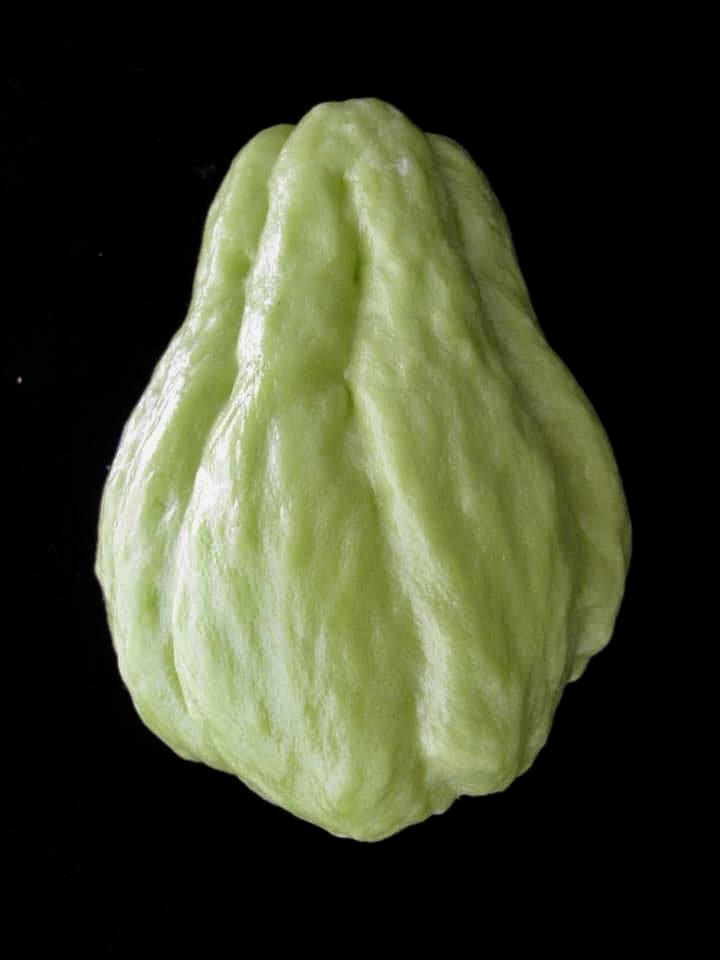
Mirliton is the name people gave the chayote (Sechuim edule) when it first arrived in Louisiana. Chayote is the main species and there are many subspecies (subvarieties) around the world with different names. They are what botanists call a “landrace.” Landraces are domesticated plants that developed over time and adapted to their natural environment and are not the product of human manipulation–such as plant breeding or modern genetic science. Haitians brought the first mirlitons to Louisiana over two centuries ago and that landrace thrived because it was adapted to our altitude, climate, pests, and diseases.
Since the Louisiana variety has never been analyzed genetically, we have had to use the fruit appearance to classify it and its subvarieties. The Louisiana mirliton landrace has distinctive fruit traits (morphology); they are large, slightly pear or egg-shaped, with smooth skin, longitudinal furrows (though a few may be unfurrowed), and either green or white. Over the years other varieties were probably introduced from Mexico and Central America and interbred with the Louisiana landrace. The resulting landrace was what generations of Lousianians simply called “mirlitons.” And for most of the last two centuries, there was only one variety.
Then things changed. Hurricane Katrina wiped out almost all the mirlitons in New Orleans, so I began to search for growers of our Louisiana landrace to replace the New Orleans ones. I eventually found many growers in rural areas and when I did, I would name the mirliton after the grower so that we could track and preserve it.
I soon noticed differences within Louisiana mirlitons–there were clearly different subvarieties in the landrace. Mirlitons were more complex than we thought. I decided to classify the subvarieties by fruit morphology and then interview the growers to determine the strain’s history. If it were a unique variety, we would name the variety so we could track and preserve it. That’s how “named varieties” came to be.
We have reached the point in 2024 where we have identified most of the Louisiana subspecies. To simplify matters, from this point forward, we will classify mirlitons into three categories for purposes of discussion on our Mirliton.Org Facebook group:
- Certified Heirloom Mirliton: A variety that was submitted to Mirliton.Org for visual review and met all the heirloom criteria. Anyone can submit photographs of their variety for review at no cost. If we certify it, you can say on the Mirliton.Org Facebook group that you are growing a “certified heirloom mirliton.” Submit photos to lance@mirliton.org or at the Mirliton.Org Facebook group. We maintain a public list of all certified heirlooms that you can refer people to verify that you are growing a certified variety.
- Certified Named Heirloom Mirliton: These are varieties that were submitted to Mirliton.org in the past that met all the requirements and were sufficiently unique that Mirliton.Org named them for tracking and preservation purposes.
- Louisiana Heirloom Mirliton: These are the varieties grown along the Gulf Coast south that were obtained from an unknown source (a local farmer, a seed store, etc.), and the grower sincerely believes they are Louisiana heirlooms. If you are growing one of these uncertified varieties, you can simply say it’s an “heirloom mirliton” or “Louisiana heirloom.”
There are currently 14 Certified Named Heirloom Varieties:
Ervin Crawford
Ishreal Thibodeaux
Boudreaux-Robert
Blacklege
Papa Sylvest
Bogalusa whites
Chauvin-Rister
Miss Clara
Remondet-Perque
Joseph Boudreaux
Bebe Leblanc
Maurin
Jody Coyne
Dupuy-Prejean
Why is it important to continue tracking heirlooms? Beginning in 2020, several large grocery store chains began importing chayote (mirlitons) that looked exactly like our heirloom varieties. People began buying them, using them as seeds, and growing mirlitons indistinguishable from our heirloom varieties. The problem is that imported chayote may carry a seed-transmissible virus that can destroy our heirlooms. It’s called Chayote Mosaic Virus (ChMv), which devastated crops in other countries. Recent research has also discovered new strains of anthracnose in Brazilian chayote that can be transmitted inside the fruit.
We created the certification process to help preserve and popularize the Louisiana heirloom variety. We recommend that the best way to accomplish this is to use only certified heirloom seeds.